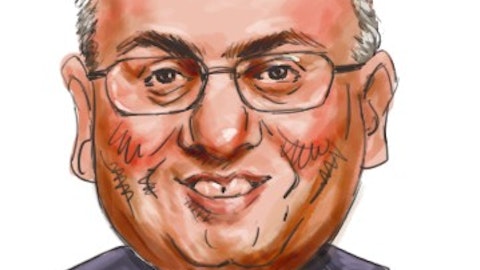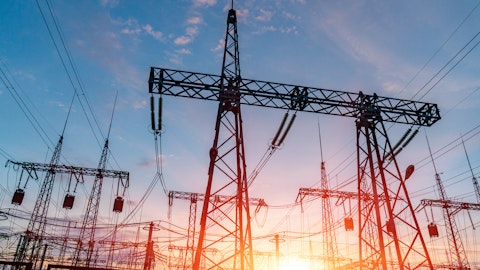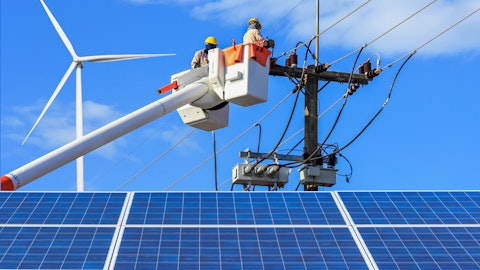WEC Energy Group, Inc. (NYSE:WEC) Q4 2022 Earnings Call Transcript February 2, 2023
Operator: Good afternoon, and welcome to WEC Energy Group’s Conference Call for Fourth Quarter and Year End €˜22 Results. This call is being recorded for rebroadcast, and all participants are in a listen-only mode at this time. Before the conference call begins, I remind you that all statements in the presentation other than historical facts are forward-looking statements that involve risks and uncertainties that are subject to change at any time. Such statements are based on management’s expectations at the time they are made. In addition to the assumptions and other factors referred to in connection with these statements, factors described in WEC Energy Group’s latest Form 10-K and subsequent reports filed with the Securities and Exchange Commission, could cause actual results to differ materially from those contemplated.
During the discussions, referenced earnings per share will be based on diluted earnings per share, unless otherwise noted. After the presentation, the conference will be open to analysts for questions and answers. In conjunction with this call, a package of detailed financial information is posted at wecenergygroup.com. The replay will be available approximately two hours after the conclusion of this call. And now, it’s my pleasure to introduce Gale Klappa, Executive Chairman of WEC Energy Group.
Gale Klappa : Good afternoon, everyone. Thank you for joining us today, as we review our results for calendar year 2022. First, I’d like to introduce the members of our management team who are here with me today. We have Scott Lauber, our President and Chief Executive; Xia Liu, our Chief Financial Officer; and Beth Straka, Senior Vice President of Corporate Communications and Investor Relations. Now, as you saw from our news release this morning, we reported full year 2022 earnings of $4.45 a share. Xia will provide you with more detail on our financial metrics in just a few minutes. But I’m pleased to report to you that we delivered an exceptional year on virtually every meaningful measure from employee safety and customer satisfaction to growth in earnings per share.
Three major factors really shaped our strong results for 2022: favorable weather; solid performance from our infrastructure and transmission segments; and steady execution of our capital plan, as we paved the way for an energy future that’s affordable, reliable, and clean. On the regulatory front, as you may know, we saw balanced and credit supportive results from our Wisconsin rate reviews in December, despite a little bit of noise in the process. New rates are now in effect for all of our Wisconsin utilities. And last month, on January 6th, we filed rate requests with the Illinois Commerce Commission for our gas utilities in Illinois. I would point out that home heating bills in Chicago are currently below those of other major U.S. cities, like New York, Boston, Baltimore, and Philadelphia.
And we expect that to continue with this filing. Scott will provide you with more detail in just a moment. Turning now to our ESG progress plan that we updated for you in November. It’s the largest five-year investment plan in our history, totaling $20.1 billion for efficiency, sustainability, and growth. We expect the plan to drive compound earnings growth of 6.5% to 7% a year over the period 2023 through 2027. The key part of the plan is a major commitment to renewable projects, both in our regulated business and in our infrastructure segment. In fact, earlier this week, we announced that our infrastructure group will acquire an 80% ownership interest in Phase 1 of the Samson Solar Energy Center. Located in Northeast Texas, Samson I has a capacity of 250 megawatts.
It entered commercial service in May of last year and has a long-term power purchase agreement with AT&T. Pending final regulatory approval, we plan to invest approximately $250 million for our portion of Samson I. We expect to close the transaction late in the first quarter of this year. Samson I, as you may know, is the first of 5 phases being developed by Invenergy. Overall, Samson is the largest solar project under construction in the United States today, and we’re pleased to take part in Phase 1. Now, as you know, one of our goals is to help shape the future of clean energy. And today, we’re announcing an important pilot project with the Electric Power Research Institute and a company called CMBlu Energy. CMBlu is a German designer of long duration battery storage using common low-cost, environmentally-friendly materials.
In simple English, it’s a green battery. This 1 to 2 megawatt hour pilot project will be one of the first of its kind on the United States electric grid. Our plan is to test the durability of this battery system. We believe it can store energy for up to twice as long as the typical batteries in use today. We plan to launch the project at our Valley Power Plant near downtown Milwaukee in the fourth quarter of this year when temperatures turn cold. The results will be shared in early 2024 across the industry. And now, let’s switch gears and take a brief look at the regional economy. Wisconsin added 52,000 private sector jobs in 2022, and in December, the unemployment rate in the state dropped to 3.2%. That’s well below the national average. We believe the current strength and remarkable diversity of the Wisconsin economy positions us well as we move forward in 2023.
And with that, I’ll turn the call over to Scott for more information on our regulatory developments, our operations, and our infrastructure segment. Scott, all yours.
Scott Lauber: Thank you, Gale. I’d like to start with some updates on the regulatory front. First, let’s review where we stand for the Wisconsin Public Service Commission’s written orders this past December. The commission authorized return on equity of 9.8% for all our Wisconsin utilities. It approved an increase in the equity component of our capital structure to 53%. We’ll also continue the earning sharing mechanism to provide benefits to Wisconsin customers if our performance exceeds our forecast. And as Gail mentioned, we now have rate filings under review in Illinois for Peoples Gas and North Shore Gas. At Peoples Gas, we are not seeking an extension of the automatic bill adjustment rider known as QIP, after it expires at the end of this year.
We plan to return to the traditional rate making process to recover the cost of necessary infrastructure improvements. Our rate request would continue to support those key capital investments. Peoples Gas operates one of the oldest natural gas delivery networks in the United States. And as you may recall, an independent engineering study found that over 80% of the iron pipes in the system are approaching the end of their useful life. We are modernizing the system to ensure safety and reliability and to reduce methane emissions. With natural gas prices declining, we project customer bills will remain largely flat as the new rates take effect in 2024. You may also recall we filed a rate review at one of our smaller utilities, Minnesota Energy Resources last November.
We are seeking an overall increase of 8.1%, primarily driven by capital investments. Interim rates went into effect January 1st. Meanwhile, we’re making good progress on a number of our regulatory capital projects. Our Red Barn wind development is on track to come online within the next few months in Wisconsin with an expected investment of $160 million. This project will provide about 80 megawatts of renewable energy to our system. Work continues on the Badger Hollow II solar facility and the Paris Solar Battery Park. We still expect the solar parks to go into service this year, assuming timely release of the panels. We also received regulatory approval for our purchase of the Darien Solar-Battery Park, with plans for 225 megawatts of solar capacity and 68 megawatts of battery storage.
We expect this facility to go into service in 2024. Of course, we’ll keep you updated on any future developments. And just last month with an investment of approximately $75 million, we closed our purchase of the Whitewater combined cycle plant, a 236 megawatt facility. As a reminder, we previously received energy and capacity from this natural gas unit under a purchase power agreement. In the natural gas business we have been working to bring high quality renewable natural gas to our customers. We signed another contract in January, which brings us to a planned total of 1 billion cubic feet of RNG that’ll enter our system annually. We expect RNG to flow this year, supporting our aggressive goals to reduce methane emissions. Outside our utilities, we continue to make good progress on zero carbon projects in our WEC Infrastructure segment.
The Thunderhead Wind Farm in Nebraska is now in service. In addition, we expect to complete the acquisition of Sapphire Sky in Illinois in the coming weeks as commercial operation begins. And as Gale noted, we’re excited about our plans to add the Samson I solar project in our infrastructure segment before the end of the first quarter. And with that, I’ll turn things back to Gale.

Suwin/Shutterstock.com
Gale Klappa: Great, Scott. Thank you very much. We’re confident that we can deliver on our earnings guidance for 2023. As you recall, we’re guiding to a range of $4.58 to $4.62 a share. The midpoint $4.60 a share represents growth of 6.7% from the midpoint of our original guidance last year. And as we’ve discussed, we expect to fund our capital plan without any need to issue equity. And you may have seen the announcement that our Board of Directors at its January meeting raised our quarterly cash dividend by 7.2%. This marks the 20th consecutive year that our company will reward shareholders with higher dividends. We continue to target a payout ratio of 65% to 70% of earnings. We’re right in the middle of that range now, so you can expect our dividend growth will continue to be in line with the growth in our earnings per share. Next up, Xia will provide you with more detail on our financial results and our first quarter guidance. Xia, all yours.
Xia Liu: Thanks, Gale. Turning now to earnings. Our 2022 earnings of $4.45 per share increased $0.34 per share or 8.3% compared to 2021. Our earnings package includes a comparison of 2022 results on page 17. I’ll walk through the significant drivers. Starting with our utility operations, we grew our earnings by $0.19 compared to 2021. Weather drove a $0.04 increase in earnings compared to 2021. Rate base growth contributed $0.41 to earnings, and lower day-to-day O&M expense resulted in a $0.02 improvement and achieved our goal for the year. These favorable factors were partially offset by $0.12 of higher depreciation and amortization expense related to continued capital investment and a $0.12 increase in fuel expense, mainly driven by higher natural gas costs.
In terms of sales, on a weather-normalized basis, retail electric deliveries in Wisconsin excluding the iron ore mines, were up 0.1%. Small commercial and industrial sales increased 0.5%, while residential and large commercial and industrial sales stayed relatively flat. Overall, our sales mix was stronger than our forecast. Our sales projections for 2023 can be found on Pages 13 and 14 of the earnings package. Overall, we are projecting relatively flat electric and gas sales year-over-year. Regarding our investment in American Transmission Company, earnings increased $0.07 compared to 2021. If you recall, $0.05 related to the resolution of historical appeals that we discussed on our third quarter earnings call. As previously discussed, beginning with the third quarter of 2022 and going forward, we are recording ATC earnings at a 10.38% return on equity.
Earnings at our Energy Infrastructure segment improved $0.14 in 2022 compared to 2021. This was mainly driven by production tax credits as a result of stronger wind production and the addition of our Jayhawk wind farm that went into commercial operation at the end of 2021. In addition, recall that we recognized a $0.03 earnings contribution earlier in 2022 from the final resolution of market settlements in the Southwest Power Pool. Finally, you’ll see that earnings at our Corporate and Other segment decreased $0.06, primarily driven by rabbi trust performance and lower gains recognized on our investment in the clean energy fund. Remember, rabbi trust performance is largely offset in O&M. Overall, we improved on our 2021 performance by $0.34 per share.
Looking now at the cash flow statement on page 6 of the earnings package. Net cash provided by operating activities increased $28 million. And total capital expenditures and asset acquisitions were $2.7 billion in 2022, a $324 million increase as compared to 2021. As you can see, we have been executing well on our capital plan. Finally, let’s look at our earnings guidance. In terms of first quarter 2023 earnings guidance, we project to earn in the range of $1.68 per share to $1.72 per share. This forecast takes into account the fourth warmest January on record since the 1880s and assumes normal weather for the rest of the quarter. Remember, last year, we earned $1.79 per share in the first quarter, which included $0.02 of favorable weather, $0.03 from the Southwest Power Pool settlement and $0.03 from our investment in the clean energy fund.
And for the full year 2023, we’re reaffirming our annual guidance of $4.58 to $4.62 per share. We’re also reaffirming our long-term earnings growth of 6.5% to 7% a year over the next five years. With that, I’ll turn it back to Gale.
Gale Klappa: Xia, thank you. Overall, we’re on track and focused on providing value for our customers and our stockholders. Operator, we’re ready now for the question-and-answer portion of the call.
See also 12 Best One Dollar Stocks To Buy and 13 Cheap DRIP Stocks To Buy.
Q&A Session
Follow Wec Energy Group Inc. (NYSE:WEC)
Follow Wec Energy Group Inc. (NYSE:WEC)
Receive real-time insider trading and news alerts
Operator: Our first question from Shar Pourreza with Guggenheim Partners.
Gale Klappa: Rock and roll. Shar, you’re ready for the West Coast?
Shar Pourreza: I am ready for the West Coast. I’m packing my bag just.
Shar Pourreza: Just two quick ones for you. Just on the transmission CapEx with ATC, which obviously just pretty healthy uptick. In the past, I know you’ve said you were seeing increases as early as 25 for Tranche 1 with LRTP and additional investments even earlier in €˜24. I guess, can you maybe talk about the cadence of this current increase as we’re thinking about the spending profile? And do you see more opportunities? Any sense on how you’re thinking about Tranche 2?
Gale Klappa: Yes. Great question, Shar. Let me unpack the second piece of the question first, if that’s satisfactory. On the second piece of the question really about Tranche 2, and again, just to level set everyone, MISO is going through a very thorough and rigorous long-term planning process for transmission investment in the region. They have been through and have now completed Phase 1 Tranche 1 — I’m sorry, Future 1 Tranche 1. So now we’re into Future 1 Tranche 2. And it’s a little too early to tell you precisely what we’re seeing in the planning for Tranche 2. But I can tell you that what we’re seeing so far in the stakeholder discussions at MISO is that — is I think a good probability that the amount of investment opportunity for American Transmission Company in Tranche 2 is potentially greater than what we’re even seeing in Tranche 1.
So, we’re optimistic about that. I would expect that we will be able to give you more detail before the end of this year on kind of the broad numbers as they emerge in the planning process. And Scott, would you like to handle kind of the cadence question?
Scott Lauber: Sure. So, when you look at — and we’ll hear the end of this year or the beginning of next year as Tranche 2, we’ll just see how fast that process goes. When you look at the projects, starting to ramp up really in €˜24 and €˜25, and that’s related to Tranche 1, but also, we saw a lot of entries here at American Transmission Company just looking at connecting renewables on the state. So, that was about half of our increase in the prior year along with Tranche 1. So, I expect we’re going to see more of that as we look forward over the next 5 to 10 years, too.
Gale Klappa: Shar, Scott is making a good point. Not only are we seeing the need for additional transmission related to these longer term projects that are part of the MISO planning but just to hook in the significant number of renewable projects being built in Wisconsin, that’s an additional uptick, if you will, in our plan from just the Wisconsin connections for many renewable projects under development here.
Shar Pourreza: Got it. Perfect. And then, just lastly, just Gale, on the current 5-year plan. I know you guys budgeted roughly $1.9 billion in the Infrastructure segment. Obviously, you had two recent announcements with investing in sort of PTC eligible solar projects, I think, for the first time, obviously, in this segment. How are you sort of thinking about the remaining $1.1 billion of capital, I think you plan to deploy in this business? And should we expect more solar, more wind, or perhaps can you open it up to other technologies, which are obviously now PTC eligible post IRA? Thanks.
Gale Klappa: Shar, we certainly could open it up to other technologies, but the big likelihood, given what we’re seeing in the pipeline of projects that we’re doing due diligence on, the big likelihood is they will largely be solar and wind. And you’re referring to the announcement we just made a couple of days ago, the Samson 1 Solar Energy Center in North Texas. That project, we’re very pleased to be a part of. It is coming in a little earlier. I think internally, we all thought that we would probably add another solar project toward the end of 2023. So, that’s actually good news that it’s coming in a little earlier. And as I mentioned, we hope to close on that transaction final — given final regulatory approval late in the first quarter. I hope that helps, Shar.
Shar Pourreza: It always does. And Scott always makes good points, by the way. I appreciate it, guys, and I’ll see you soon.
Gale Klappa: Sounds good. Great. Thank you, Shar.
Operator: Our next question comes from Julien Dumoulin-Smith with Bank of America.
Gale Klappa: Good afternoon, Julien. Julien, are you and your wife buying a dog yet?
Julien Dumoulin-Smith: Oh, my God. Just you wait, just you wait. I’ll give you the update next quarter. Oh, my God. So, just coming back to Wisconsin really quick. Just reopen your filing, if we can talk about super quickly. Obviously, there’s been a lot of attention of late. Perhaps just at the outset, any comments and reactions of what’s transpired here and just how to think about that reopener? And then within that, just a couple of subpoints, just West Riverside, how confident are you that you’ll be able to submit data to prove the benefits for WEC are greater or at least equal to LNC? And then with respect to Oak Creek, some of the same considerations around what are the unrecovered balances of scrubbers and other plant? And do you see any specific obstacles around Oak Creek retirement and recovery on that front?
Gale Klappa: Okay. Well, let’s kind of — I’m glad you got it all out. Let’s try to kind of walk through that, if I forget, Scott and Xia, any of the elements of the question, Scott and Xia will help remind me. But first, I think you were asking about the “limited reopener€ that was part of the rate decision in December. So the limited reopener is for 2024, and it truly is a limited reopener relating to the investment cost of several projects that will be coming into service over the course of 2023. All of them regulated projects — I think virtually all of them are really the renewable projects, Scott, that we are underway with here. So, the limited reopener is simply to reopen and put into rates recovery of the investment costs for projects that have already been approved and are under development, Scott, got by the commission.
Scott Lauber: Yes. It’ll be very specific. For example, the liquefied natural gas plants we have going on in our gas system, some of the renewable projects I talked about in the prepared remarks, and some of the new RICE units that we have going in, in Weston. So, it’s very specific projects. For instance, LNG goes in at the end of the year, we’ll just factor that in for a full year then. So, those — that should be very straightforward as we do that filing.





